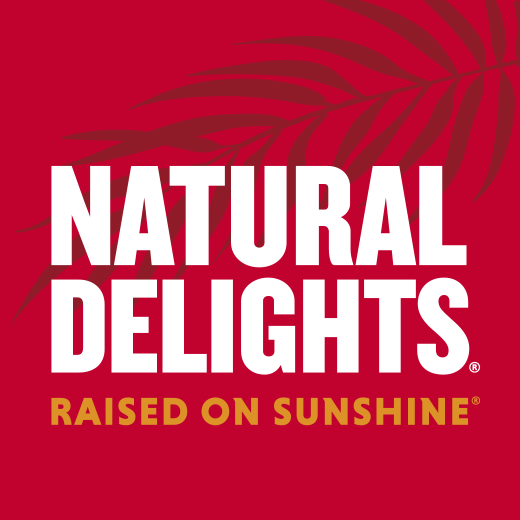.png?width=550&name=Blog%20Header%20Images%20(8).png)
When you’re at home pulling out those shiny green containers with juicy Medjool dates, you likely don’t think much about all the effort it took to get those dates to your door. Sure, the bright packaging says things like “fresh” and “raised on sunshine,” but what exactly does that mean? Believe it or not, the Medjool date has a rich history dating back six millennia, and every single fruit is harvested by hand. From the journey to the United States to the sunshine fields of the Bard Valley, all the way to packaging, processing, and shipping to stores, here is everything you need to know about these tasty little stone fruits—and all of the delicious recipes you can make.
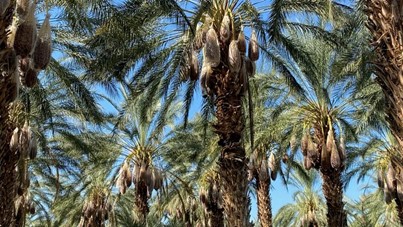
Considered the “world’s oldest cultivated fruit,” Medjool dates have been grown and harvested from palm trees for over 6,000 years. Date palms thrive in hot and arid climates and originate in areas of the Middle East and North Africa. Some ancient cultures even called these palms the “trees of life” thanks to these sweet, juicy fruits.
Although Medjool dates have such a long, rich, cultural history, these tasty stone fruits did not make it to the United States until 1927 when Dr. Walter T. Swingle from the U.S. Department of Agriculture (USDA) brought over 11 different offshoots from Morocco. This particular voyage to America was crucial in keeping the Medjool date alive; a case of Bayoud disease—a date palm fungal disease—destroyed crops along the Mediterranean and almost wiped out the Medjool date entirely. To protect these plants from disease, the USDA planted these offshoots in isolation in Nevada before eventually being transferred to California where Medjools have now been grown for over 120 years.
Natural Delights Medjool Dates are specifically grown in the Bard Valley—right on the border between California and Yuma, Arizona. The location next to the Colorado River creates the perfect microclimate for growing date palms; high heat and lots of sunshine.
Harvesting Medjool dates may only take two or three weeks, but growing these fruits is a year-long process of labor and love. The process starts with farmers removing thorns and branches from the palms that would be sharp and dangerous during harvest. Once the flowers of the tree bloom, farmers hand-pollinate the female trees.
Farmers also ensure that the Medjool dates grow to the proper size by thinning out the branches, tying up the branches to prevent breakage, and using metal rings to space the fruits out. Without the proper amount of room, the dates wouldn’t be the big, juicy fruits we know and love! Mesh bags are eventually tied around the fruits to prevent birds and insects from eating the fruits—and to catch any fruits that may fall. The fruits ripen between late July through late September, and once they are ready, the harvest begins!
Date farmers will spend their days under the sun, up in the trees. They untie the bags and gently shake them, allowing the dates to tumble down into baskets. Once all of those ripe dates are safely in baskets, farmers tie up the bags and move on to the next. On average, the date farmers at Natural Delights are collecting 270 pounds from a single palm during harvest!
Dates are graded based on size, color, and ripeness. Blemishes such as broken skin, skin separation, scarring, and stretch marks are also considered when categorizing dates to ensure you get the tastiest, juiciest, best-looking fruit every time.
But don’t worry, no date goes to waste! Any dates that don’t fit the proper qualifications are ground up and used in some of our delicious snacking products like Mini Medjools.
Once the dates are dried and sorted, they are packaged in our 100% post-consumer recycled plastic containers and shipped off to stores near you. Natural Delights Medjool dates are pesticide-free, additive-free, and Non-GMO Project Verified.
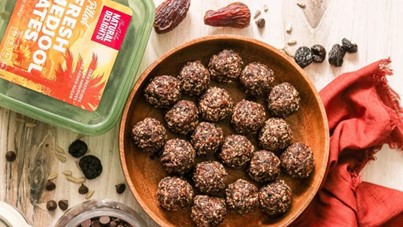
There’s a reason why Medjool dates are known for coming from the “trees of life.” Not only do they have that sweet, caramel-like taste, but they are also full of good-for-you nutrients that benefit your body in numerous ways.
Yes, dates do have a higher amount of sugar (about 15 grams per one fruit), yet these sugars are naturally occurring from the fruit itself—no added sugars here!
“Eating Medjool dates will likely give you an energy boost without the ‘sugar crash,’” says Mackenzie Burgess, RDN, a recipe developer at Cheerful Choices and a nutrition partner for Natural Delights. “That’s because alongside their natural sugars, Medjool dates have fiber (a complex carbohydrate) which helps slow down digestion.”
A serving is considered two Medjool dates, which gives you 4 grams of gut-happy fiber, which is 14% of your recommended daily value. These tasty fruits are also high in key vitamins and minerals like iron, potassium, calcium, magnesium, vitamin D, and vitamin B6.
“They’re considered nourishing to eat because, alongside the natural sugars, you have fiber and a variety of vitamins and minerals that keep us healthy,” said Burgess. “That being said, just like with all foods, it's important to practice moderation. Generally, you may want to stick to about 2 to 4 dates per day.”
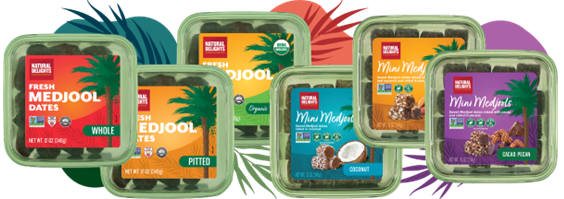
Believe it or not, Medjool dates are considered a fresh fruit! While you may find varieties of dates in the dried food section of the grocery store, containers of Natural Delights Medjool Dates will actually be found in the refrigerated produce section.
Once your dates are secured, it’s best to store them in your refrigerator as well. Kept in their air-tight containers, the dates are able to stay fresh and retain their moisture for as long as possible. Medjool dates can be stored for up to six months in the fridge—or by their “Best Before” date indicated on the packaging.
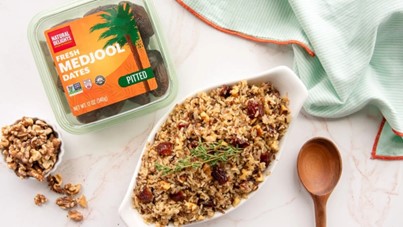
Besides eating Medjool dates as a snack on their own (yes, they’re that good!), there are a number of tasty ways to cook with dates in the kitchen. Burgess loves to prep snacks with like Dark Chocolate Cherry Energy Bites, Frozen Yogurt Bark with Berries, “Date Snickers” stuffed with peanut butter and covered in dark chocolate, or chopped up small in cookies like these whole wheat Date Apple Cookies. Dates also make for easy, fiber-rich ways to add in sweetness to your daily smoothies or bowls of oatmeal for breakfast.
More of a savory person? Dates work well for savory dishes, too! Some of our favorites include Moroccan Date and Carrot Salad, this Date and Goat Cheese Grilled Flatbread, and this Wild Grain Casserole with Caramelized Onions, Dates, and Walnuts.
Kiersten Hickman is a freelance journalist and content strategist, covering a variety of topics in the food, health, and lifestyle categories. Her work has been published by The Kitchn, Taste of Home, Reader's Digest, EatingWell, INSIDER, Eat This, Not That!, Clean Plates, Bustle, Stacker, The Everygirl, and more. She also writes Forkful, a weekly essay on Substack debunking diet culture myths, and publishes novels under the pen name K. Sinko.
Subscribe for fresh recipes, helpful tips, and exclusive offers!
